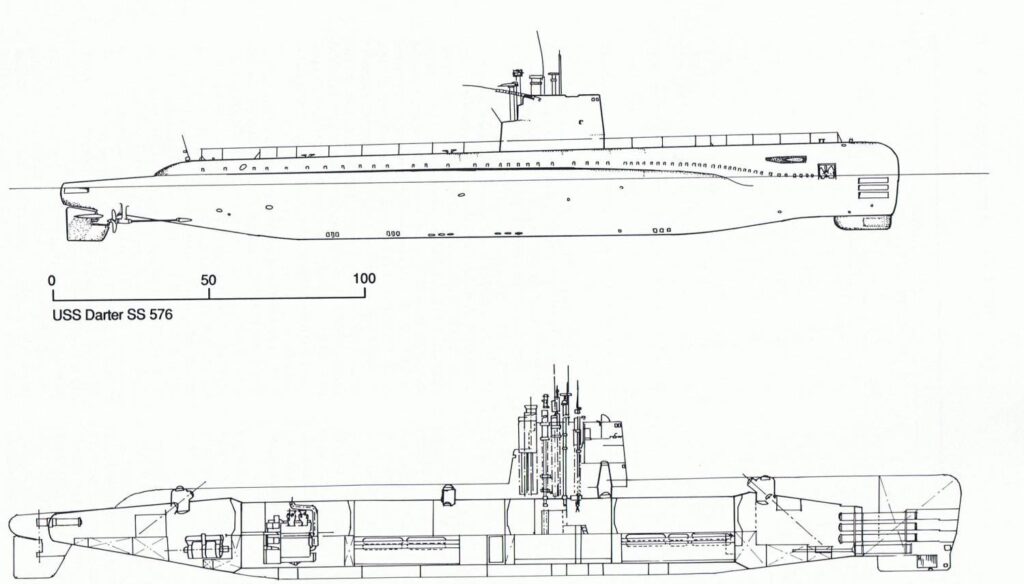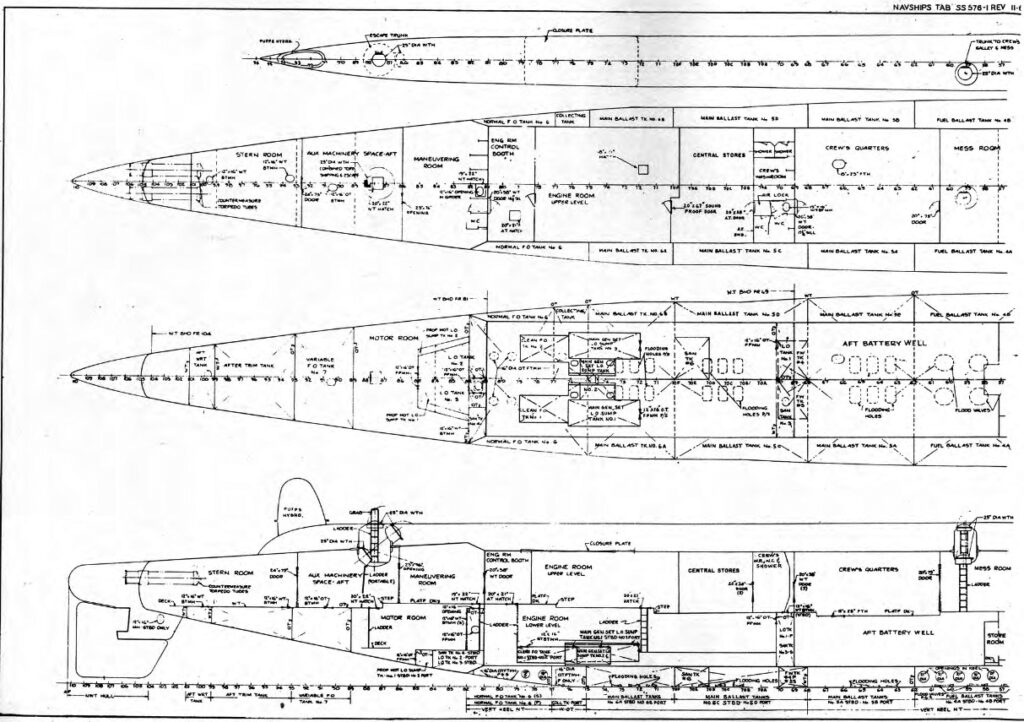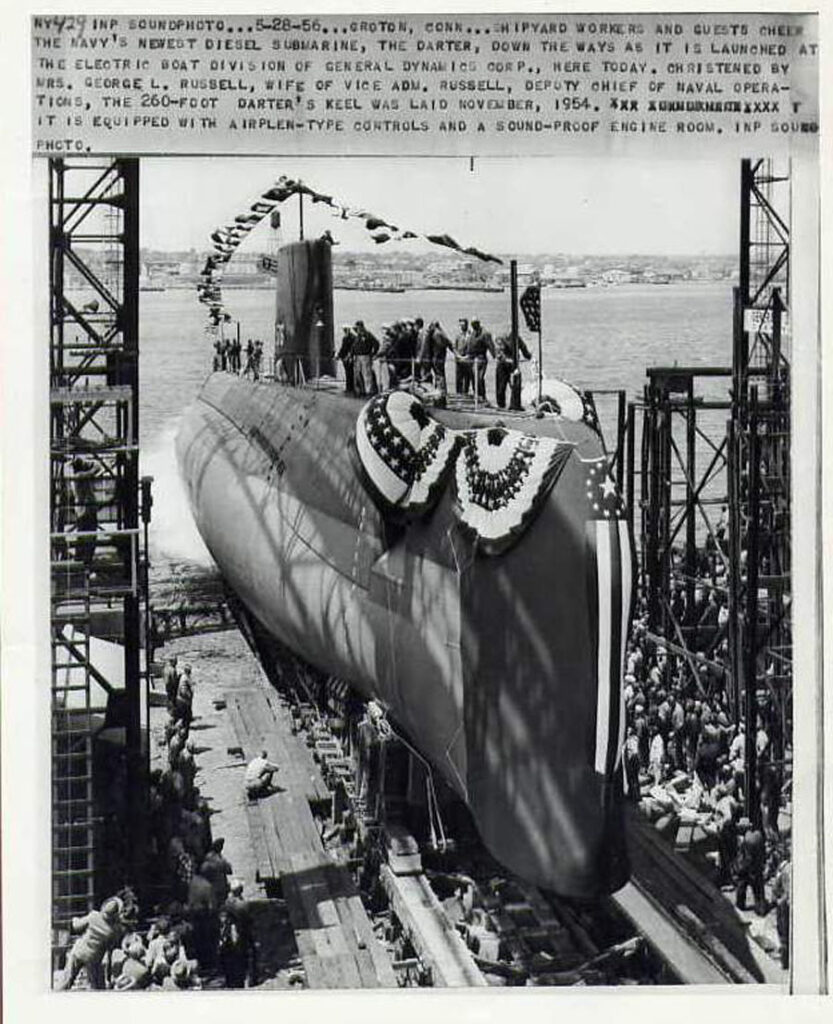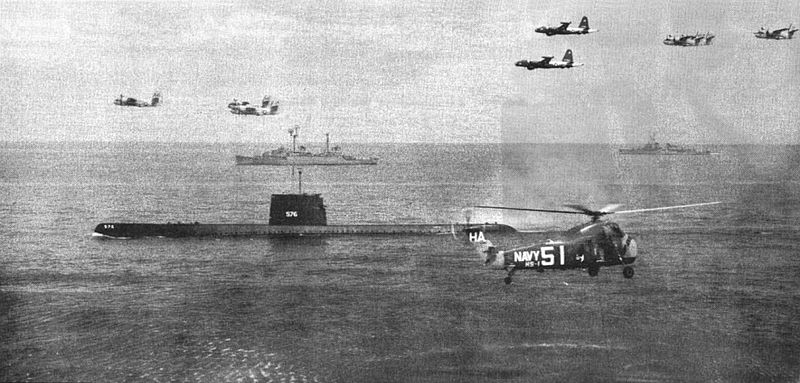 Conventional Attack Submarine 1956-1989.
Conventional Attack Submarine 1956-1989.
[wpcode id="44777"]
An experimental conventional hunter killer
USS Darter (SS-576) was essentially a repeat
Tang class incorporating many improvements. Name officially by BuShips
project SCB 116, she integrated more sophisticated acoustic, but also completely new electronic and a new fire control gear as new generation hunter-killer submarine close to USS Tang (SS-563) but experimenting scores of innovations, notably a three-man helmsman-planesman station with aircraft-style stick controls. She was second named "Darter" after a famous WW2 vet,
Gato class submarine SS 227, both after a type of small American fresh-water fish.
After design was approved in early 1954, Contract was awarded to Electric Boat Division (General Dynamics Corp.) Groton, Connecticut, on 30 June 1954. Her keel was laid down on 10 November and she was launched on 28 May 1956, commissioned on 20 October 1956. She originally was part of a class of three, succeeding to the Tangs, with her planned sisters USS Grayback and Growler. But the latter were completed instead as strategic missile submarines and completely modified (future dedicated post).
USS Darter was completed in just six months, so quicker than average. She would served actively from October 1956 until 1989, almost seeing the end of the cold war, albeit stricken in 1995 and not recycled until 1995. That was remarkable for a conventional attack submarine given the confidence in new SSNs in the US Navy for range and speed. She served for 33 years.
She was not the last conventional attack submarine of the USN: This went to the Barbel class (launched 1958), first and last with the USS Albacore's streamlined hull.
Design of the class







Links to General plans,
USS-Darters-FullPlans and
USS-Darters-FullPlans2, compartment & access and her trim & drain system. She overhauled at Mare Island from 3/15/76 to 5/29/76.
Hull and general design
USS Darter was almost a repeat of the Tang class, albeit larger. She displaced 2,372 long tons (2,410 t) versus 2,260 long tons submerged for the Tangs, was longer at 285 ft 3 in (86.94 m) versus 268 ft (82 m), but with the same width at 27 ft (8.2 m) overall, 25 ft (7.6 m) at the waterline and deeper at 19 ft (5.8 m) versus 17 ft (5.2 m). Her hull was very similar to the Tangs, albeit a bit longer. Her appearence also changed over time and upgrades. Her outlook was less advanced than Nautilus or Seawolf, with a clear separation between the pressure and upper hull, open conning tower and cut sail aft. Her sail was modified during her late 1960s refit, fully enclosed and taller.
Her fin contained originally the SS 2A radar mast port, the UHF-IFF antenna, retractable whip to port, ECM/DF antenna also to port, VLF loop starboard and Snorkel induction and exhaust at the rear.
Darter innovated notably with her new snorkel mast, tested on her and later used on all later U.S. subs. Her ECM mast carried stub dipoles along its lengt ending with a top dome for the direction-finder. The UQC-1 transducer was also on top of the sail, close to the UHF-IFF mast. The CT's masts line went down enough to divide internal spaces, between a port control room, starboard attack center, and separate radio, room abaft the control room and sonar room.
She had her plane controls athwart-ships, placed on the forward bulkhead of the control room with six main controls, automatic depth control, UQC along the pressure hull.
Powerplant
Lucky enough not to have been equipped with the mediocre "pancake diesels" of the previous Tang class she directly skipped to the trusted Fairbank Morse diesel-generators (3,100 shp), of which three were provided, connected through a differential to two 2 Elliott electric motors (4,700 shp) and then passed on to two shafts. All three diesels were compact enough to be side by side in a single engine room abaft her crew spaces. These were enough for a limited 15.5 kn (17.8 mph; 28.7 km/h) surface speed and not really impressive 16 knots (18 mph; 30 km/h) submerged. But her goal was not to flee escorts, but to hunt down enemy submarines. She mostly relied on a first class acoustic suite, the best ever fitted on a US submarine so far. Her range was still reasonable, at 13,500 nautical miles at 10 knots, of 144 nautical miles at 3 knots. She could proceed on any sea far from US waters without refulling, and had a reserve for operations locally. Test depth was 700 ft (210 m).
Armament
In all she had eight 21-inches (533 mm) torpedo tubes, six forward, two aft (she was one of the last with this configuration). The ones in the bow fired Mk 54 torpedo tubes, and this in the stern Mk 55 torpedoetubes. In all she also carried 26 torpedoes of the Mark 35. This model was studied in WW2 as a synthesis from the Marks 24, 32 and 33. 400 were produced between 1949 and 1952 and it was service until 1960, replaced by the Mark 37. The fire control system fed final data through a 1" (25 mm) diameter umbilical cable cut away during tube expulsion. This was an anti-subarine torpedo first and foremost, with surface targets secondary. It could received pre-enabled run-out course/distance, search ceiling and floor data as well asright or left circling search pattern.
⚙ Torpedo specifications |
| Weight | 1,770 lbs. (803 kg) |
| Dimensions | 13 ft 5 in (4.089 m) |
| Propulsion | Electric-Battery, seawater |
| Range/speed setting | 15,000 yards (13,710 m)/27 knots |
| Warhead | 270 lbs. (122.5 kg) HBX |
| Guidance | Active and passive acoustic, spiral search |
Sensors
BPS-12 radar: Medium-range surface search and navigation radar, modified BPS-5, similar to BPS-14, periscope antenna and conventional antenna.
BQS-4: Active/passive detection sonar, AN/BQR-2 passive detection system and added active detection capability. Chin bow dome.
BQR-2 sonars: Cylindrical (or circular) array mounted in chin dome.
BLR-1 ECM suite: No info yet.
In the late 1960s she obtained the new BQG-4 sonar and later before end of the decade, she had the BLR-1 ECM suite removed and replaced by the new WLR-1 ECM suite. This was her last upgrade.
⚙ specifications |
| Displacement | 1,620 long tons (1,650 t) surfaced, 2,372 long tons (2,410 t) submerged |
| Dimensions | 285 ft 3 in x 27 x 19ft (86.94 x 8.2 x 5.8 m) |
| Propulsion | 2 shafts Diesel-electric, |
| Speed | 15.5 kn (17.8 mph; 28.7 km/h) surfaced, 16 kn (18 mph; 30 km/h) submerged |
| Range | Unlimited |
| Test Depth | 700 ft (210 m) |
| Armament | 8× 21 in (533 mm) TTs (6 fwd, 2 aft), 26 torpedoes total |
| Sensors | BPS-12 radar, BQS-4, BQR-2 sonars, BLR-1 ECM suite |
| Crew | 8 officers and 75 enlisted men |
USS Darter's career
 Shipyard workers and guests cheer the Navy's newest Diesel submarine SS-576 on 28 May 1956, photo courtesy of San Francisco Examiner via David S. Smith, http://www.navsource.org.
Shipyard workers and guests cheer the Navy's newest Diesel submarine SS-576 on 28 May 1956, photo courtesy of San Francisco Examiner via David S. Smith, http://www.navsource.org.
USS Darter was commissioned on 20 October 1956 and after sea trials, initial training, was assigned to the Atlantic fleet, starting exercises locally from homeport Newport (Rhode Island) but also the West Indies in winter, and up to Newfoundland, Canada in summer, with cruisers to Europe on, interspaced with NATO operations. After an overhaul at Portsmouth, she was homeported to Charleston in South Carolina, from 1 August 1959. There, she was task to escort newly commissioned fleet ballistic missile submarines in undersea ASW component. She operated in the West Indies and off Key West and was requisitioned at various times by the Chief of Naval Operations (CNO) for various tasks and experiments.
 USS Darter early in her career with ships and aicraft during an exercize in the 1960s.
USS Darter early in her career with ships and aicraft during an exercize in the 1960s.
When not in local waters, she was deployed for overseas service, notably in the Mediterranean, 6th fleet, in 1963 and 1967. Her major modernization overhaul was done at Charleston Naval Shipyard in 1965 were she received a host of upgrades:
-16-foot (5 m) hull extension ("plug" aft, fwd of the engine room)
-Upgraded engines
-New safety gear (SUBSAFE)
-Better electronic suite with AN/BQG-4 Passive Underwater Fire Control Feasibility System (PUFFS) passive sonar.
PUFFS was recoignised to the three shark-fin domes topside.
In 1971, she was homeported to San Diego, California, for the Pacific fleet. She made four Western Pacific (WestPac) deployments with the 7th Fleet. In 1978 she had her head valve failing while snorkeling and surfaced, revealing herself during a realistic ASW exercize. On 8 May 1979 she was homeported to Sasebo, Japan, as forward-deployed submarine for ten years. Between US fleet exercizes she made numerous joint operations with the
JMSDF (Japanese Navy),
ROKN (South Korean Navy) Thai and Malaysian Navy, but also British Royal Navy and the RAN, including in Australian waters. She was deployed also in special operations, stopped virtually at all islands of the Western Pacific and south China sea from Singapore to Hong Kong, the Philippines, Guam and others. She became the submarine platform for U.S. Navy SEALS as well as USMC Recon Marines and U.S. Army Special Forces in several of these specops missioens and exercises, earning a Battle Efficiency Award (Battle "E") in 1980, 1982 (she won seven total over the years).
 USS Darter towards the end of her career, post-PUFFS upgrade. She arrived in port for ammunition loading at the Macerate Ordnance Facility on 25 April 1989. USN photo #DN-ST-90-11777 by PH1 Brian R. Lee, from the Department of Defense Still Media Collection, courtesy of dodmedia.osd.mil & submitted by Bill Gonyo. Creative commons fund.
USS Darter towards the end of her career, post-PUFFS upgrade. She arrived in port for ammunition loading at the Macerate Ordnance Facility on 25 April 1989. USN photo #DN-ST-90-11777 by PH1 Brian R. Lee, from the Department of Defense Still Media Collection, courtesy of dodmedia.osd.mil & submitted by Bill Gonyo. Creative commons fund.
In mid-1982 she had another overhaul at Subic Bay. In September 1985, she collided while submerged with the tanker Kansas Getty, hitting also her anchor chain, causing hull damage. This happened near Pusan in Korea. She was repaired at Sasebo. The tanker was undamaged and the crew barely notice the collision.
Darter was eventually decommissioned in Pearl Harbor, 1 December 1989, setting a career record for conventional or any US submarines. In addition to her "E" she won many departmental excellence awards. Stricken on 17 January 1990 she was spent as target on 7 January 1992, hit by torpedoes of USS Tautog (SSN-639) off Pearl Harbor.
Read More/Src
Books
Friedman, Norman (1994). U.S. Submarines Since 1945: An Illustrated Design History. NIP
Conway's all the world's fighting ships 1947-1995
Links
navsource.org
navypedia.org/ships/usa/us_ss_darter.htm
navweaps.com cold war us torpedoes
en.wikipedia.org/
www.ss563.org/
seaforces.org/
navysite.de/crewlist
historyhub.history.gov/
Videos
https://youtu.be/QSu3WSjuuaU
USS DARTER SS-576 DECOM CREW & WW2 VETS (1989)






 Links to General plans, USS-Darters-FullPlans and USS-Darters-FullPlans2, compartment & access and her trim & drain system. She overhauled at Mare Island from 3/15/76 to 5/29/76.
Links to General plans, USS-Darters-FullPlans and USS-Darters-FullPlans2, compartment & access and her trim & drain system. She overhauled at Mare Island from 3/15/76 to 5/29/76.


 USS Darter early in her career with ships and aicraft during an exercize in the 1960s.
When not in local waters, she was deployed for overseas service, notably in the Mediterranean, 6th fleet, in 1963 and 1967. Her major modernization overhaul was done at Charleston Naval Shipyard in 1965 were she received a host of upgrades:
-16-foot (5 m) hull extension ("plug" aft, fwd of the engine room)
-Upgraded engines
-New safety gear (SUBSAFE)
-Better electronic suite with AN/BQG-4 Passive Underwater Fire Control Feasibility System (PUFFS) passive sonar.
PUFFS was recoignised to the three shark-fin domes topside.
In 1971, she was homeported to San Diego, California, for the Pacific fleet. She made four Western Pacific (WestPac) deployments with the 7th Fleet. In 1978 she had her head valve failing while snorkeling and surfaced, revealing herself during a realistic ASW exercize. On 8 May 1979 she was homeported to Sasebo, Japan, as forward-deployed submarine for ten years. Between US fleet exercizes she made numerous joint operations with the
USS Darter early in her career with ships and aicraft during an exercize in the 1960s.
When not in local waters, she was deployed for overseas service, notably in the Mediterranean, 6th fleet, in 1963 and 1967. Her major modernization overhaul was done at Charleston Naval Shipyard in 1965 were she received a host of upgrades:
-16-foot (5 m) hull extension ("plug" aft, fwd of the engine room)
-Upgraded engines
-New safety gear (SUBSAFE)
-Better electronic suite with AN/BQG-4 Passive Underwater Fire Control Feasibility System (PUFFS) passive sonar.
PUFFS was recoignised to the three shark-fin domes topside.
In 1971, she was homeported to San Diego, California, for the Pacific fleet. She made four Western Pacific (WestPac) deployments with the 7th Fleet. In 1978 she had her head valve failing while snorkeling and surfaced, revealing herself during a realistic ASW exercize. On 8 May 1979 she was homeported to Sasebo, Japan, as forward-deployed submarine for ten years. Between US fleet exercizes she made numerous joint operations with the 